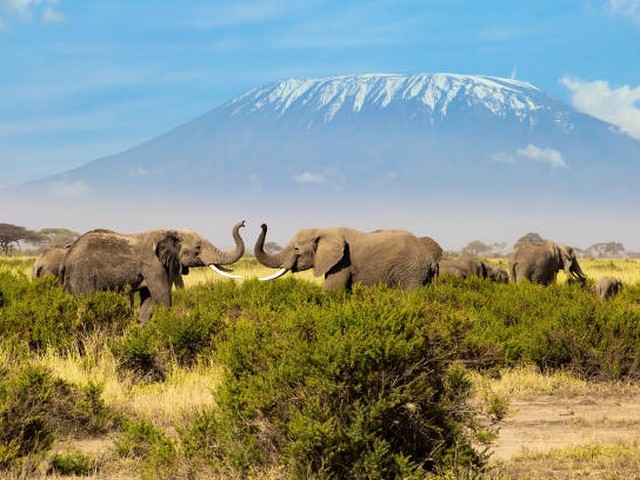Best High-altitude Training For Kilimanjaro Trekking
Embarking on a journey to the iconic Mount Kilimanjaro is not just a trek; it’s a life-changing adventure. At Kilimanjaro Centre for Trekking and Ecotourism (KCTE), we understand that the key to a successful and enjoyable climb lies in proper preparation—specifically, in high-altitude training. Whether you’re a seasoned hiker or a first-time adventurer, this guide will help you train for the physical demands of high-altitude trekking and ensure you’re ready to conquer the Roof of Africa.
Why High-altitude Training is Crucial
At 5,895 meters (19,341 feet), Mount Kilimanjaro is the highest peak in Africa and one of the world’s largest stratovolcanoes. The thin air at such elevations contains less oxygen, which can challenge even the fittest climbers. High-altitude training is essential not only for enhancing your endurance and strength but also for acclimatizing your body to lower oxygen levels. This preparation minimizes the risk of altitude sickness and maximizes your chance of a successful summit.
Start with Aerobic Conditioning
Building Your Base Stamina
Your training should begin with enhancing your aerobic capacity. Activities like running, cycling, and swimming are excellent for increasing your cardiovascular endurance. Aim to incorporate these exercises into your routine at least three to four times a week, gradually increasing the intensity and duration to build your stamina.
The Power of Interval Training
To simulate the varying intensity of trekking up and down hills, interval training is invaluable. It involves alternating between high-intensity bursts and periods of lower intensity or rest. This type of training not only boosts your aerobic capacity but also your recovery efficiency—a vital component when climbing Kilimanjaro.
Strength and Core Training
Focus on Your Legs and Core
Strong legs will carry you up the mountain, and a strong core will keep you stable and balanced over uneven terrain. Incorporate exercises like squats, lunges, and step-ups into your routine. Additionally, planks, and other core strengthening exercises are crucial for building the necessary endurance that trekking demands.
Don’t Forget the Altitude Aspect
While general physical preparedness is fundamental, specific exercises can help simulate the effects of high altitude. Training masks, which restrict airflow to your lungs, can mimic high-altitude conditions and can be a useful tool in your training regimen.
Psychological Preparation
Mental Stamina and Resilience
The mental and emotional challenges of climbing Kilimanjaro should not be underestimated. Engaging in activities that develop your resilience—such as meditation, yoga, or even challenging outdoor activities that require persistence—can prepare you mentally for the journey ahead.
Visualization Techniques
Regularly visualize the trek, from the initial ascent through different terrains to the summit. Mental rehearsals like these can improve motivation and reduce anxiety, effectively preparing you for the real experience.
Practice Hikes
Simulate the Kilimanjaro Experience
Engage in practice hikes that closely mimic the Kilimanjaro trek. Seek out local trails that offer a range of elevations and terrains. Gradually increase the length and difficulty of your hikes to build your trekking-specific fitness and to adjust to long durations of walking.
Train in Your Trekking Gear
Use these hikes as an opportunity to break in your hiking boots and get accustomed to your backpack and other gear. This not only helps in avoiding discomfort during the actual climb but also allows you to adjust to the physical load you will carry.
Nutrition and Hydration
Fueling for High-altitude Energy Needs
Adjusting your diet to increase your intake of carbohydrates can be beneficial, as carbs are a key energy source during prolonged physical activity. Also, ensure you’re getting enough protein for muscle repair and recovery.
Staying Hydrated
Proper hydration is critical, especially at high altitudes where the risk of dehydration is increased. Learn to monitor your hydration levels and practice maintaining optimal hydration during your training hikes.
Join a Training Group or Program
Participating in a training group or specialized program can provide structured training and support. At KCTE, we offer tailored training programs designed specifically for Kilimanjaro climbers. These programs focus on all aspects of preparation, from physical training to acclimatization strategies.
Why Choose KCTE for Your Kilimanjaro Adventure
With years of experience and a deep commitment to sustainable tourism, Kilimanjaro Centre for Trekking and Ecotourism is your ideal partner for an unforgettable climbing experience. Our expert guides, comprehensive training programs, and unwavering support ensure your journey to the summit is safe, enjoyable, and successful.
Conclusion: Ready to Conquer Kilimanjaro?
Preparing for Kilimanjaro is no small feat, but with the right high-altitude training, you’ll be well-equipped to tackle the challenges and reap the incredible rewards that await at the summit. Remember, the journey to the top is as spectacular as the destination itself.
Are you ready to take the first step towards the adventure of a lifetime? Contact KCTE today, and let us help you prepare for and achieve your Kilimanjaro dream!
FAQ
Q: How long should I train before attempting to climb Kilimanjaro?
A: Ideally, you should start training at least 6 months before your planned climb to adequately prepare your body and mind for the high altitudes.
Q: Can I train for Kilimanjaro at home if I don’t have access to mountains?
A: Absolutely! While mountain hikes are beneficial, you can train at home using stairs, a treadmill, and strength training exercises to build your endurance and strength.
Q: What is the best time of year to climb Kilimanjaro?
A: The best times to climb Kilimanjaro are during the dry seasons, from June to October and from December to March.
Q: How do I deal with altitude sickness during the trek?
A: Proper acclimatization is key. KCTE’s itineraries are designed to allow climbers to ascend gradually, maximizing acclimatization and minimizing the risk of altitude sickness.
Ready to make your Kilimanjaro dreams a reality? Book your climb with Kilimanjaro Centre for Trekking and Ecotourism (KCTE) and start your journey to the summit with confidence and enthusiasm!




